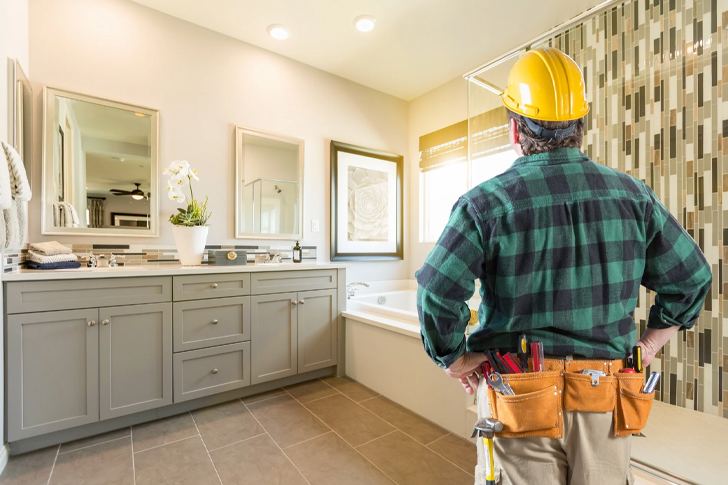2024 US: Comprehensive Guide to Budget-Friendly Bathroom Renovations
Renovating a bathroom in 2024 can be expensive due to rising costs, but careful planning and strategic choices can achieve a stunning update affordably. This guide covers steps for cost-effective renovations in the U.S., focusing on budget-friendly strategies.

The Current Landscape of Bathroom Renovation Costs
The cost of bathroom renovations in the United States continues to be influenced by various factors, including geographic location, local economic conditions, labor rates, and the materials used. Here’s a more detailed look at average renovation costs across ten populous and diverse regions in 2024:
- California: Costs range from $13,000 to $28,000, with higher labor and material costs, particularly in urban areas like San Francisco and Los Angeles.
- Texas: More moderate costs ranging from $8,000 to $16,000, with variations seen between cities like Houston and Austin.
- Florida: Similar to Texas, costs range from $8,000 to $16,000, with slightly higher costs in coastal areas due to humidity and salt air considerations.
- New York: On the higher end, renovations cost from $12,000 to $30,000, significantly influenced by the high cost of living and stricter building codes in New York City.
- Illinois: In Chicago and surrounding areas, costs range from $9,000 to $18,000, reflecting the urban cost structures.
- Pennsylvania: Costs range from $7,500 to $15,000, with Philadelphia typically on the higher end due to its historic homes needing more careful renovations.
- Ohio: Costs are relatively lower, ranging from $6,500 to $13,000, reflecting the more moderate cost of living.
- Georgia: In Atlanta and surrounding areas, costs range from $7,500 to $15,000, depending on the scale and luxury of materials used.
- North Carolina: Renovation costs range from $7,000 to $14,000, with costs varying slightly between the more rural areas and cities like Charlotte.
- Michigan: Costs in places like Detroit can range from $7,500 to $15,000, influenced by local economic conditions and the availability of skilled labor.
Budgeting for Your Renovation
- Setting a Clear Budget: Begin with a clear financial plan. Set aside a contingency of 10-20% for unexpected costs.
- Cost Breakdown: Typically, labor accounts for 40-50% of the total cost, with materials making up the remainder. Factor this in when planning DIY aspects of your remodel.
Choosing Materials and Fixtures
- Tiles: Consider porcelain tiles that mimic more expensive materials but are much less costly and durable.
- Fixtures and Fittings: Look for trade discounts and wholesale options. Many manufacturers offer significant markdowns on last season’s stock.
- Vanities and Countertops: Composite materials can offer the look and durability of stone but at a fraction of the cost.
DIY vs. Professional Help
- DIY Projects: Simple projects like painting, installing basic fixtures, or updating hardware can be done yourself.
- Professional Help: For electrical and plumbing, professional help is necessary. Get at least three quotes to ensure competitive pricing.
Timing and Scheduling
- Off-peak Discounts: Schedule your renovation during the off-peak season (late fall to early winter) when contractors are less busy and may offer discounts.
- Permitting: Allow extra time for permits, especially in strict regulatory environments like California and New York.
Technological Advancements and Sustainability
- Smart Technology: Consider smart showers, faucets, and lighting that can help save water and energy, which is particularly appealing given the rising energy costs in 2024.
- Sustainability: Green materials can be cost-effective in the long run due to their durability and efficiency. Look for low-flow toilets and showers to reduce water usage.
Regional Considerations
Different regions in the U.S. have varying requirements and costs:
- Midwest: Generally lower renovation costs. Consider local materials and products to cut down on shipping costs.
- Southeast: Higher humidity can affect material choices; moisture-resistant materials are advisable.
Long-term Investment
While upfront costs are important, consider the long-term savings associated with higher-quality, energy-efficient installations. These can significantly reduce future maintenance and utility costs.
Conclusion
A bathroom renovation in 2024 doesn’t have to be prohibitively expensive. By understanding the factors that influence costs, making strategic decisions about materials and labor, and taking advantage of technological advancements, you can successfully navigate the process within your budget. This not only enhances your home’s comfort and aesthetic but also boosts its overall value.







Recent Comments